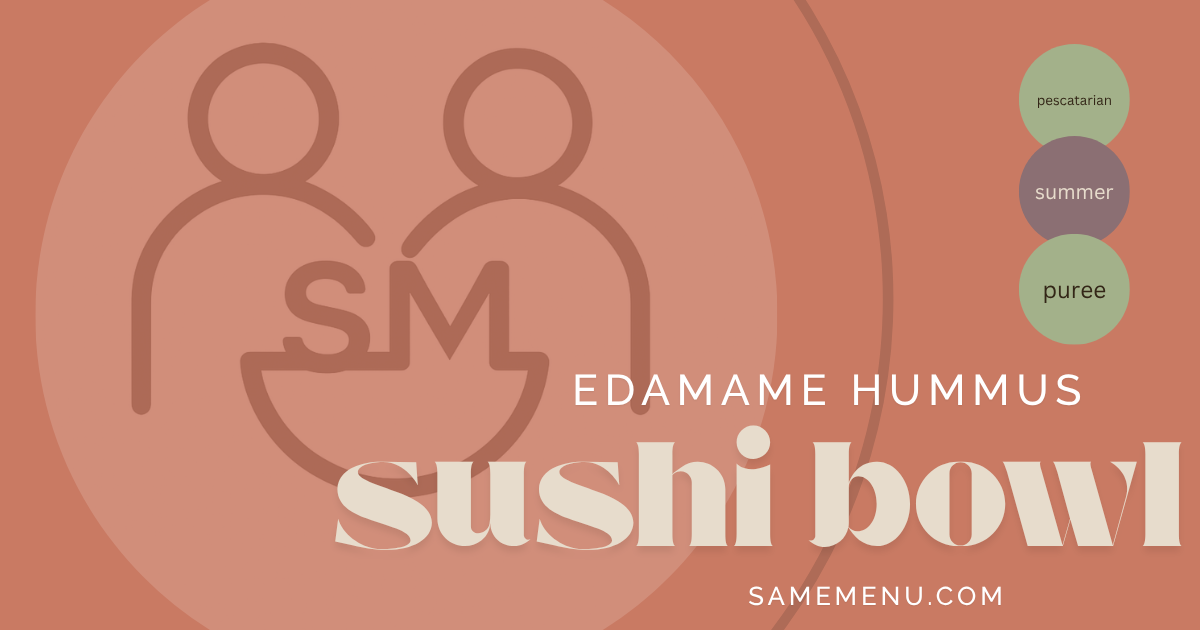This altered-texture sushi bowl offers all the beloved flavors of sushi but in a soft, smooth form that’s safe and satisfying. The edamame hummus provides a creamy, high-protein base that compliments the umami-rich taste of wasabi and soy. The softened rice and finely diced meat add a gentle texture variation without compromising safety, while the pickled cucumber and soy glaze round out the dish with a tangy, savory finish.

Soft and Savory Sushi Bowls
Ingredients
Equipment
Method
- In a food processor, blend the edamame, tahini, rice vinegar, soy sauce, garlic, and half the water until smooth and creamy. Season with salt to taste.
- Add water/broth to the rinsed sushi rice and bring to a boil, then reduce to a simmer and cover for 16 minutes to ensure the sushi rice is extra soft by slightly overcooking it. Allow it to rest with lid on for an additional 10 minutes.
- Peel, seed, and finely chop the cucumber, adding to a bowl of rice vinegar for at least 10 minutes.
- Assemble the bowl starting with a generous layer of edamame hummus as the base of your bowl. Add a layer of softened rice on top, gently pressing it into the hummus. Layer the pickled cucumber and diced tuna or imitation crab. Drizzle the soy glaze over the top for an extra savory umami flavor. Optional Garnish: A sprinkle of sesame seeds or dash of sesame oil
Notes
- Puree 4 (PU4): Prepare the ingredients as above, blending each separately with water, glaze or broth to reach a thick, pudding-like texture. Layer the edamame hummus with pureed rice, pureed cucumber, and pureed tuna/crab in a bowl. Select a bite straight down to achieve the full sushi effect. Drizzle a small amount of soy glaze on top for presentation and flavor.
- Minced & Moist 5 (MM5): Spread a layer of mashed, moist rice. Top with finely minced cucumber and the protein of your choice, with pieces smaller than 4mm, tossed in the edamame hummus to keep everything together. Drizzle with the glaze.
- Soft & Bite-sized 6 (SB6): Form small rice bites spread the edamame hummus or pieces on top, followed by cucumber and protein of your choice.
Drizzle a small amount of soy glaze to enhance flavor. - Easy to Chew 7 (EC7): Same as Soft & Bite-Sized above.
- Protein: Starting around 25-30g, opt for the tuna vs imitation crab for higher and up the ratio of meat, or add tofu.
- Fats: 18-22g is where the original recipe lands; you can tweak the oil content in the hummus, remove sesame seed/oil garnishments. To add more healthy fats, avocado is a great match with the flavors.
- Carbs: You can log 35-40g as is or swap a portion of rice for cauliflower and go for the tuna, and/or skip the glaze to reduce.
- Gluten-free: Swap tamari sauce for the soy sauce; most imitation crab is not gluten-free so swap with tofu, jackfruit, or hearts of palm.
- Dairy-free/Vegan: Use extra edamame or tofu for the protein. Check that your soy sauce doesn’t use fish extracts; you can mix tamari, maple syrup and rice vinegar.
- Prep in parts: Hummus keeps 3–4 days in fridge and rice can be batch cooked for meal prep and frozen in small portions for simpler reheating later.
- Buy prepped: Buy precooked edamame (frozen, thawed) and jarred pickles instead of quick pickling cucumber.
- Skip steps if needed: Just do hummus, rice, and protein if chopping veggies is too much effort/dishes.
Why Embracing Altered Textures Matters
These variations offer safe, delicious options for those with specific chewing or swallowing needs, making the dining experience inclusive and enjoyable. By creating different versions of this sushi inspired bowl, restaurants and caregivers can provide flavorful, nutritious meals without compromising safety. These recipes prove that texture-modified diets can still deliver on taste and presentation, transforming every meal into an enjoyable, shared experience.
Quick pickling is a fantastic technique for enhancing flavor and adding a burst of acidity to dishes. It’s especially useful when creating modified-texture meals, as it softens ingredients like cucumbers while infusing them with the tangy notes of rice vinegar, salt, and a touch of sweetness. Quick pickling involves slicing or chopping the vegetables, then soaking them in a vinegar solution for just 10–30 minutes. This process transforms the texture, making the vegetables easier to chew or puree, depending on the IDDSI level needed, without losing their vibrant taste or color. By adjusting the pickling time, you can customize how soft or crisp each piece is to match your specific needs.
Bringing the sushi experience home is not only accessible but also incredibly rewarding, especially for those with altered-texture requirements. With a few simple techniques, like quick pickling and pureeing, you can enjoy all the flavors of sushi in a way that’s tailored to your safety and comfort. By recreating classic sushi elements in softer forms, you can maintain the layered tastes and aesthetics that make sushi so special. Whether it’s through the creamy base of edamame hummus, soft rice, or pickled veggies, these modified-texture dishes make it possible to enjoy a beloved cuisine at home, bringing joy and inclusivity to the dining experience.
Leave a Reply